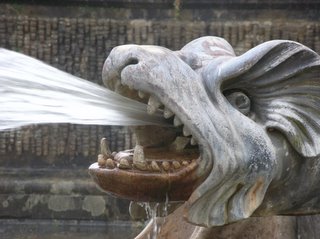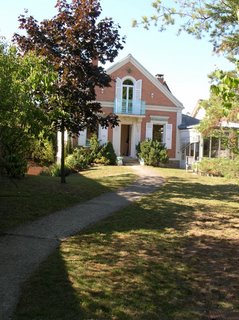
OK, so the first time I went to Versailles was about five years ago, and I only had time to visit the gardens; so I did not make it inside the royal living quarters. But at any rate, here is the reaction I had the first time I was there: I walked thru the gate to enter the central garden area and you think: what a nice garden, isn't this interesting. And then, you walk about another 50 meters ... and then you see the garden. What you had seen was really just a patio. And then you say (depending on where you are from, but in my case): "Holy Excessivity! This is unbelieeevable." We are not talking about a garden here. I think basically what we are talking about is maybe the size of New Jersey, but all of it incredibly well manicured.
So then my next thought was this: What took them so long to have a revolution? I mean really, why would you finance a lifestyle like this for some fancy-pants royalty while everyone else is living baguette to mouth. I don't know what King George had in England at the same time, but I imagine if he had tried to build a place like Versailles near Boston or New York or Philadelphia, the revolution would have come just that much sooner.
So this year, I thought it would be fun to take Jen, and just gauge her reaction as this whole thing unfolds before her. It was really a beautiful sunny fall afternoon. I swear to Neptune, she had exactly the same reaction. She wandered across the patio, nodding agreeably about how nice the place is, and then all of a sudden: recognition of the enormity of this place, and then she had basically the same thought I had: "This was all for ONE guy?"
Really, it is that enormous. Kinda makes you wonder how the mob were even able to find Louis XVI and Marie-Antoinette when they knocked on the door in October 1789. If Crawford, Texas starts to develop a reputation for impressive water sculptures, let's start re-reading the Constitution.
OK, so don't get me wrong. I am not negative about the beauty of this place.

It is stunning.
It is a marvel of design.
It is a joyous way to spend the day, wandering about and imagining the 18th century coming alive in all of it's regal regalitry. They even pipe in some nice baroque music to help re-create the ambience.
All I am saying is: let's also keep in mind who paid for all of this.
Appended below for your viewing pleasure are some images from the day. The water sculptures were big this day, so these photos are heavy on the water theme; in conjunction with the water fountains there is also an enviable collection of plant diversity, and all very nicely maintained and manicured in a very french-y formal garden style.


And, if you do get a chance to visit, here is my recommendation for the most stunning water / sculpture / garden I have ever seen. The sculpture is called le bosquet d'Encalade. This sculpture depicts the demise of Enceladus during the giants' failed revolt against Zeus. Enceladus was one of the 24 giants that revolted, attempting to reach Mt. Olympus by stacking mountain upon mountain. As it become obvious that the battle was lost, Enceladus attempted to escape, but Athena crushed him under a large piece of extracted earth, that is now the land of Sicily. Go figure.
Happy gardening!





